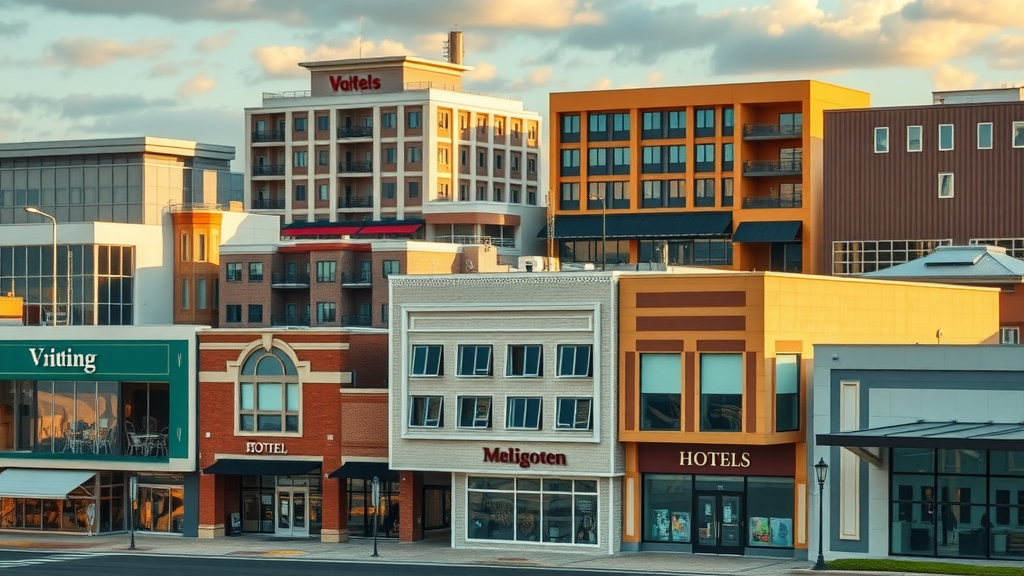Did you know commercial real estate is projected to outpace residential properties in growth by the coming year—yet most business owners aren’t preparing for the next market surge? Finding the right commercial real estate for business before prices escalate can mean the difference between thriving and merely surviving. This guide unpacks current trends, investment strategies, and actionable steps to help your business secure premium property—before opportunity slips away.
Why Commercial Real Estate for Business Is Poised for a Boom
"The commercial real estate market is anticipated to grow by 8% over the next year, signaling a unique window of opportunity for proactive business owners."
The commercial real estate market is experiencing accelerated growth due to surging demand for office space , warehouse facilities, and mixed-use developments. As remote work trends shift, businesses are recalibrating their footprint—with many seeking flexible spaces in thriving business districts. The spike in e-commerce has further boosted demand for industrial and retail properties, outpacing traditional residential leases in rental income and long-term value.
Unlike the volatility seen in the stock market , the real estate sector offers relative stability and higher cash flow opportunities. Leasing and investing in commercial property can safeguard your company against price escalations expected as the economy rebounds. For businesses aiming to expand or solidify their market presence, acting now can secure favorable lease rates and lucrative investment terms before demand pushes prices even higher.
Understanding the Current Real Estate Market Trends
Today’s commercial real estate market is defined by flexibility, technology integration, and demand for versatile property types . Developers are focusing on adaptable office buildings and shopping centers designed to accommodate hybrid workforces and new business models. Meanwhile, industrial parks near city centers are becoming essential as logistics and last-mile delivery requirements grow.
The shift from large, static office buildings to smaller units and shared office space rentals is especially pronounced in urban areas. Mixed-use properties that combine office, retail, and even hospitality elements are increasingly sought after, blending experience with convenience for employees and customers alike. These trends in commercial real estate point to higher rental income potential, especially for early investors and tenants.

For a deeper dive into the specific strategies that can help you act before the next price surge, you may want to review this comprehensive guide on commercial real estate for business and how to act before prices rise . It offers actionable tips and market insights that complement the trends discussed here.
Key Factors Driving Price Increases in Commercial Real Estate for Business
Several key factors are accelerating price growth in the commercial real estate market . First, urbanization and infrastructure developments are drawing more companies into central business districts. As local economies bounce back, competition for prime office space, retail centers, and industrial facilities intensifies.
Second, macroeconomic influences—such as low interest rates and increased investor appetite for higher returns compared to residential properties—push up valuations. Additionally, advancements in building technologies and sustainability standards can increase both the appeal and the price points of new commercial developments . Business owners anticipating these trends can secure better deals before these factors drive prices even higher.
Unlocking Business Potential Through Commercial Real Estate for Business
Owning or leasing the right commercial property can fundamentally elevate a company’s market position. Unlike residential properties, commercial real estate offers opportunities for business growth, brand visibility, and improved operational efficiency. This section reveals how making the right property decisions enables businesses to unlock strategic advantages in today’s competitive climate.
What Makes Commercial Real Estate an Investment Advantage for Businesses?
Investing in commercial real estate for business allows companies to build equity, generate stable rental income, and enjoy long-term appreciation. These properties tend to have longer lease durations, providing improved revenue predictability—something rarely matched by residential leases or the stock market. Additionally, commercial properties can often be customized to meet evolving business needs, supporting productivity and growth.
Unlike residential properties, which primarily offer personal shelter or straightforward rental income, commercial real estate enables greater diversification. Businesses can use their property as both work environment and a business asset, leveraging it for collateral or trading up as opportunities arise. The ownership of an office building or retail space can attract premier clients, boost credibility, and anchor a brand’s long-term strategy.
How Commercial Property Choices Impact Long-Term Business Success
The decision to purchase or lease a commercial property shapes a company’s financial flexibility. Strategic choices in property type and location influence everything from operational costs to employee satisfaction. For instance, an office space in a vibrant urban center can drive foot traffic and attract top talent, while a tailored warehouse in a logistics hub enhances supply chain efficiency.
Long-term success often stems from aligning property selection with business objectives. A business that owns its office space enjoys asset appreciation and tax advantages, whereas one leasing a flexible commercial lease maintains adaptability to scale or pivot with market needs. Owning or leasing in the right location can also be a powerful tool in business negotiations and market expansion.

- What you'll gain from this guide:
- How to identify the right types of commercial property for your business
- Strategies for commercial real estate investment & leasing
- Real world examples of successful business real estate decisions
- Mistakes to avoid in the rising real estate market
Types of Commercial Real Estate for Business: Options That Shape Growth
There is no one-size-fits-all solution when it comes to commercial real estate for business . From retail outlets and office buildings , to industrial warehouses and hospitality venues, each property type delivers unique benefits and challenges. Deciding among various property types can significantly affect your operational strategy, cash flow, and long-term scalability.
Understanding these distinctions allows business owners to assess which commercial properties best suit their current goals—and anticipate their future needs. Those who select the right commercial real estate not only ensure functionality, but also position themselves to capture new market opportunities and beat competitors to premium locations.
Overview of Property Types in the Commercial Real Estate Market
The main types of commercial real estate are office, retail, industrial, and hospitality. Office space is ideal for professional services and tech firms, often found in skyscrapers or business parks. Retail properties —from standalone shops to bustling shopping centers —serve consumer-facing businesses. Industrial properties include warehouses, distribution centers, and manufacturing facilities, vital for logistics-heavy operations.
Meanwhile, hospitality encompasses hotels, motels, and resorts catering to travelers and tourists. Each segment within the commercial real estate market operates differently in terms of leasing structure, tenant demand, and ongoing investment requirements. By mapping these characteristics to business requirements, companies can maximize operational effectiveness and minimize risk.
| Property Type | Common Uses | Typical Lease Length | Key Advantages | Ideal Business Sectors |
|---|---|---|---|---|
| Office | Workspaces, headquarters | 5-10 years | Prestige, stability, adaptability | Professional services, tech, finance |
| Retail | Stores, shopping centers | 3-5 years | Consumer traffic, visibility | Retailers, food & beverage, salons |
| Industrial | Warehouses, distribution | 5-20 years | High rental income, logistics-friendly | Manufacturing, e-commerce, logistics |
| Hospitality | Hotels, motels, resorts | Variable | Seasonal revenue potential | Tourism, events, hospitality groups |

Choosing the Right Commercial Property for Your Business Niche
Picking the perfect commercial real estate hinges on deeply understanding your business model. Service-oriented companies typically thrive in office buildings or co-working spaces close to major clients. Retailers, on the other hand, prosper in high-traffic shopping centers, while production-driven organizations lean toward industrial zones with logistical support.
Assess not just your current needs but your five- and ten-year growth projections. Engaging a professional commercial real estate agent can provide vital insights into local market dynamics and property availability. This strategic approach to choosing your property type ensures business resilience and access to scalable solutions as the market evolves.
Navigating the Commercial Real Estate Market Effectively
Entering the commercial real estate market demands more than a casual property search—it requires comprehensive market research, expert guidance, and clear investment objectives. Successful navigation ensures that your business capitalizes on prime opportunities and avoids costly pitfalls.
It’s essential to gather granular data on vacancy rates, transaction trends, and neighborhood growth patterns. Employing technology-enabled research tools and local expert networks empowers business owners to make confident, data-driven decisions in a fast-moving marketplace.
Essential Market Research Before Making a Move
Effective market research forms the bedrock of smart commercial real estate decisions. Analyze current trends, including rental rates, absorption levels, and future development plans in your target area. Study recent transactions for comparable properties to set realistic budget expectations and uncover undervalued assets.
Don’t overlook the relevance of local economic conditions, demographic shifts, and infrastructure upgrades. For instance, new transit lines or business incentives can dramatically increase property potential and appreciation. The more current your data, the greater your advantage during negotiations and investment planning.

Utilizing Local Commercial Real Estate Agents and Digital Platforms
Engaging a seasoned commercial real estate agent gives you access to off-market listings, insider information, and skilled negotiation. Local agents have deep knowledge of zoning laws, competitive lease rates, and property types that match your business profile.
Simultaneously, leverage cutting-edge digital platforms to compare multiple commercial properties , evaluate lease terms, and shortlist prospective opportunities. Technology-driven tools speed up due diligence, streamline the transactional process, and help identify the most lucrative investments—giving your business a decisive edge.
Commercial Lease or Purchase: Deciding What’s Best for Your Business
The question of whether to sign a commercial lease or pursue a direct investment is one of long-term impact. Both strategies offer distinct advantages and critical considerations that can profoundly shape your business trajectory. Understanding the differences empowers you to align your decision with growth goals and financial plans.
Ownership offers control, asset appreciation, and enhanced cash flow potential; however, leasing delivers flexibility, lower upfront costs, and the freedom to adapt as your business evolves. Assess your access to capital, risk appetite, and projected expansion timeline before choosing your commercial real estate path.
Differences Between Commercial Leases and Direct Investment
A commercial lease provides use of a property without ownership, requiring monthly rent payments and adherence to lease terms. This is ideal for businesses seeking flexibility, as you’re not tied down by long-term real estate investment or large capital requirements. In contrast, direct investment —purchasing the property outright—grants total control over renovations, future leasing opportunities, and value appreciation.
While commercial leases often involve lower up-front costs, direct investment can deliver higher returns over time. Ownership allows your business to benefit from rising real estate values and consistent cash flow via subleasing or rental income. Making the right choice depends on operational needs, long-term plans, and available resources.
Key Terms and Structures in Commercial Leases
Understanding the nuances of commercial leases is critical. Lease structures may include gross leases, net leases (single, double, triple), and percentage leases—each distributing costs and responsibilities differently. Key terms to review include escalation clauses, length of tenancy, renewal options, and maintenance obligations.
"A strategic lease agreement can provide flexible growth options for scaling businesses."
These terms directly impact your business’s cash flow, flexibility, and capacity to adapt to changing circumstances. Familiarity with common lease pitfalls and negotiation tactics can shield your business from unexpected costs and ensure a mutually beneficial relationship with your landlord.
The Process of Investing in Commercial Real Estate for Business
Investing in commercial property is a step-by-step process marked by due diligence, financial assessment, and risk evaluation. Each phase is essential to ensure that your company secures the most profitable property, maximizes returns, and mitigates potential setbacks.
It’s imperative to take a methodical approach—rushing into commercial real estate investment can lead to overlooked risks and costly errors. The smartest investors engage multidisciplinary teams, leveraging expertise in finance, legal, and construction to conduct thorough reviews before finalizing any deal.
Steps to Conduct Proper Due Diligence
Due diligence is the foundation of safe commercial real estate investment . First, conduct comprehensive property inspections to evaluate the state of the building, compliance with regulations, and operational systems. Review zoning, environmental assessments, and obtain a third-party appraisal to confirm fair market value.
Second, scrutinize existing leases, tenant profiles, and occupancy history. This clarifies expected cash flow and potential risks related to rent collection or management obligations. Lastly, work with legal counsel to check title status, identify encumbrances, and clarify transfer procedures to avoid last-minute surprises.

Understanding Cash Flow, Financing, and Returns for Commercial Investments
Cash flow analysis is vital for any commercial real estate investment . Compare projected rental income against operating expenses—such as taxes, insurance, maintenance, and financing costs—to calculate net cash flow. Ensuring positive cash flow is key to long-term sustainability.
Explore your financing options: from traditional bank loans and Small Business Administration (SBA) programs to private lenders and syndicates. Evaluate loan-to-value ratios, interest rates, and debt service obligations. Done right, a well-structured investment can yield strong returns, attractive appreciation, and provide cash reserves for business expansion or reinvestment.
How the Real Estate Investment Decision Impacts Business Outcomes
A well-chosen commercial real estate investment can transform both the operational and financial trajectory of your business. Ownership and strategic leasing alike provide opportunities for cost savings, increased stability, and enhanced brand prestige. But these outcomes are not automatic—they require ongoing analysis and proactive management.
Strategic property selection influences everything from recruitment to customer experience, while smart lease negotiations can free up working capital for other business initiatives. By continually monitoring performance metrics and adjusting to market changes, businesses can ensure sustained success from their real estate assets.
Analyzing the Cash Flow Benefits of Owning Commercial Real Estate
Owning your commercial property means every rent payment builds your equity, not someone else’s. The resulting cash flow —after factoring in expenses like taxes and maintenance—can be substantial, especially as rents in the surrounding area rise and vacancies remain low. Over time, commercial property values tend to appreciate, creating the potential for significant capital gains.
This reliable cash flow acts as a financial buffer against economic downturns or seasonal dips in revenue. Businesses that own their premises can also supplement income through subleasing unused space or capitalizing on property improvements. Compared to leasing, ownership gives greater flexibility in managing expenses and leveraging the property for business expansion or refinancing.

Mitigating Risks in the Commercial Property Market
All real estate investments carry inherent risk, but thoughtful planning can minimize exposure. Diversifying across multiple property types or geographic areas, purchasing adequate insurance, and maintaining cash reserves mitigate the impact of unforeseen events. It’s also wise to keep lease agreements flexible enough to adjust for changes in the business environment.
Regularly reassessing property value, monitoring tenant stability, and updating facilities for compliance or changing market needs will keep your investment resilient. Working with reputable advisors and conducting thorough research can reveal hidden issues before they escalate, saving your business from costly mistakes.
Location, Location, Location: Finding Commercial Real Estate for Business That Offers Competitive Advantages
The age-old real estate mantra holds truer in the commercial space than any other sector. The right location can drive foot traffic, attract exceptional talent, and forge easy access to distribution networks or clientele. A strategic address not only bolsters a company’s reputation but can elevate profitability for years to come.
Balance cost with proximity to suppliers, clients, infrastructure, and workforce. Upcoming business districts might offer better value and growth prospects than established locales—especially for startups or companies with evolving needs.
Popular Business Districts and Their Commercial Real Estate Trends
Major cities worldwide boast business districts undergoing rapid transformation. From thriving tech corridors to finance hubs and creative enclaves, these areas attract premium companies and investments. High demand for office space and rare vacancies often signal that it’s time to act quickly before price hikes.
Monitor local government initiatives, transit upgrades, and gentrification patterns—all these impact property values and rental income potential. Understanding past performance and scanning forecasts ensures your property choice matches your business's growth trajectory.

Case Study: A Business Transformation via Strategic Commercial Real Estate Investment
Consider a growing marketing agency that shifted from a crowded co-working space to purchasing its own office building in an up-and-coming business district. The move resulted in a 30% reduction in lease expenses, provided rental income through a subtenant, and gave the company collateral for future business loans.
This strategic acquisition allowed the agency to personalize its office space for brand synergy and drastically increase its visibility in the regional market. As the district continued to develop, property appreciation further boosted the agency's bottom line—showing how the right real estate investment can catalyze business transformation.
Expert Insights: Quotes on Maximizing Commercial Real Estate for Business
"Corporate real estate is central to competitive advantage in today’s fast-paced market." — Leading Commercial Real Estate Analyst
"Investing in commercial real estate for business isn’t just about location—it’s about vision." — Industry Thought Leader
Checklist: Steps to Secure Commercial Real Estate for Business Before Prices Escalate
- Shortlist property types based on business needs
- Survey prime commercial real estate locations
- Analyze current market trends and forecasts
- Engage with experienced commercial real estate agents
- Review lease and investment options
- Evaluate financing and cash flow scenarios
- Negotiate and close the deal proactively

Potential Pitfalls When Searching for Commercial Real Estate for Business
Despite robust opportunities, navigating the commercial real estate market can be fraught with risks. Overvaluing properties, underestimating operational costs, and signing inflexible lease agreements often lead to financial strain or missed growth prospects. Awareness and proactive mitigation are key.
Conducting hasty due diligence, misunderstanding complex lease structures, or neglecting to factor in future area development can result in contracts that favor the landlord or underperforming properties. Education and expert counsel are your best defenses against these avoidable pitfalls.
Mistakes to Avoid in the Commercial Real Estate Market
Common mistakes include ignoring the fine print in commercial leases , failing to accurately project future business needs, or stretching your budget on high-priced, non-strategic locations. Overlooking vital amenities and neighborhood trends can handicap a business before the doors even open.
It’s also easy to be swayed by flashy marketing or eager brokers—always verify all facts independently, visit multiple properties in person, and calculate total occupancy costs, not just monthly rent. Insufficient financial reserves or lack of flexibility in your lease or purchase contract can limit options and increase risk.

Red Flags in Commercial Leases and Investment Contracts
Be alert for red flags such as ambiguous escalation clauses, restrictive subleasing terms, or inadequately defined maintenance responsibilities. Contracts with undisclosed liabilities or unclear exit terms can turn an otherwise ideal property into a financial drain.
If a deal seems too good to be true, it probably is—especially in rapidly appreciating markets. Conduct legal reviews with real estate specialists and never hesitate to walk away from unfavorable terms. The right commercial property will support, not hinder, your business ambitions.
People Also Ask About Commercial Real Estate for Business
What is the 1% rule in commercial real estate?
Should I buy a commercial property for my business?
How to start a commercial real estate business?
What is the most profitable type of commercial real estate?
Answers to People Also Ask:
The 1% rule in commercial real estate refers to a property generating monthly rental income equal to 1% of its total purchase price—a quick test for viability.
Buying a commercial property for your business can provide stability, equity, and potential tax advantages if you plan to operate long-term.
To start a commercial real estate business, research the market, identify niches, secure financing, build networks, and understand local regulations.
The most profitable type of commercial real estate is often industrial properties or well-located office spaces, depending on the economic cycle.
Your FAQ Resource for Commercial Real Estate for Business Success
How do I assess commercial real estate cash flow projections?
Assess cash flow projections by estimating total expected rental income , then subtracting all operational and financing costs, including taxes, maintenance, and management. Review lease structures for rent escalation clauses, vacancy rates, and market comparables to validate your assumptions.
What are common types of commercial leases?
Common types include gross leases (landlord pays most expenses), net leases (tenant pays some or all property expenses), and percentage leases (tenant pays base rent plus a share of revenue). Choose a lease that meets your cash flow and operational needs.
Why is location so critical in commercial real estate for business?
Location determines access to clients, suppliers, and workforce, and affects your business reputation, rental income, and asset appreciation over time. A strategic address can place your business at the heart of market activity and spur long-term success.
"The best time to secure commercial real estate for business is before the next market surge."
Maximize Your Business Future—Secure Commercial Real Estate for Business Now
Act Before Prices Rise to Leverage Potential Investment Returns and Operational Security
Position your company for sustained success: Begin your search for commercial real estate for business now, analyze the market, consult experts, and move confidently before the next price surge locks you out of the best opportunities.
Take the next step: Explore, analyze, and secure prime commercial real estate for your business—before prices soar and opportunities pass you by.
If you’re ready to deepen your understanding and take a more strategic approach, consider exploring the broader landscape of commercial real estate for business and why acting before prices rise is essential . This resource expands on market timing, risk management, and advanced investment tactics, empowering you to make decisions that not only protect your business but also position it for long-term growth. By staying ahead of market shifts and leveraging expert insights, you can transform your real estate strategy into a true competitive advantage. Start building your business’s future with knowledge that goes beyond the basics.
Sources
- https://www.nar.realtor – National Association of Realtors
- https://www.cbrecapitalmarkets.com – CBRE Capital Markets
- https://www.forbes.com/sites/forbesbusinesscouncil/2023/08/03/commercial-real-estate-trends-to-watch/ – Forbes Business Council
- https://www.bisnow.com/national/news/commercial-real-estate – Bisnow
- https://www.ccim.com – CCIM Institute
 Add Row
Add Row  Add
Add 




Write A Comment